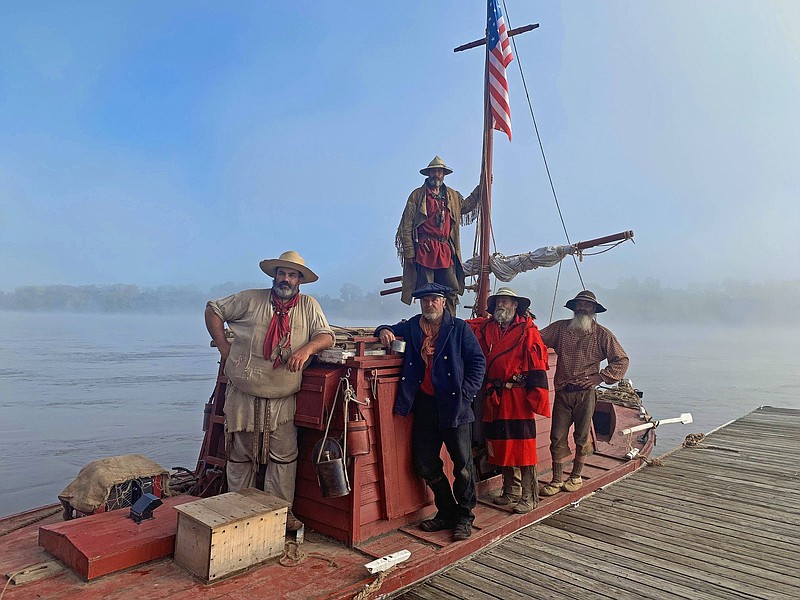For Paul Fennewald, the keelboat "Muskrat" serves as a reminder of the important role of the Missouri River today and in Missouri's history for transportation, commerce, recreation and agriculture.
The boat, built by William Bailey, is a half-scale replica of the type of boat used in fur trading on the Missouri River in the 1820s. Bailey built the boat as part of a larger journey; in 2019, he an a crew of "modern-day mountain men" set out to repeat a trip first taken in 1825 by Lt. Gov. William Ashley, who became the present-day equivalent of a millionaire after pioneering the idea to set an annual "rendezvous" with fur trappers to sell their wares and replenish supplies.
They retraced Ashley's return to St. Charles from Henry's Fork, located west of the Green River in Wyoming near the Utah border. They traveled via horseback and pack mule, then via bull boats and pirogue up the Big Horn and Yellowstone rivers to the Missouri River. The final 779 miles of the journey were taken via the "Muskrat," on a flooded Missouri River, all the way to St. Charles.
Fennewald got involved after he started meeting the crew wherever they were landing along the river, throwing them a rope so they could make it to shore. He said he even got the chance to ride along, from Chamois to Hermann.
The trip also has a small tie to Moniteau County. When Bailey was putting the trip together, Fennewald sent along two Burgers' Smokehouse hams for the crew to use for food as they came down the river.
"Because there's no refrigeration on it, no electricity, they needed food that would last," Fennewald said. "So Burgers' hams were a great thing that would sustain them, and wouldn't spoil."
When the trip was complete, Fennewald said Bailey wanted to find a place the boat could be housed so it could used as an educational tool for future generations, noting the lessons that can be learned from Ashley's actions in the 1800s. The city of Hermann agreed to take in the vessel, with the hope to one day build a museum.
Thus, the Muskrat Society was born. Fennewald, a member, said the purpose of the not-for-profit group is to help the city of Hermann find the funding to build the museum. While Hermann is the boat's de facto home, Fennewald said it has spent time in other areas as the museum effort continues. Runge Nature Center in Jefferson City was one such location, where a standing six-month display on the Missouri River fur trade is still available for viewing.
Now, however, the boat is "docked" in Fennewald's backyard in rural California - before making a stop at the Missouri State Fair in Sedalia Aug. 16-17, its next appearance will be on the streets of California next Tuesday.
The Moniteau County Historical Society is set to host an ice cream social celebrating the state's Bicentennial Aug. 10 from 3-7 p.m., and the "Muskrat" will be on the street nearby for patrons to view. Some other items will also be part of the display, and Fennewald said he plans to wear period dress as he speaks to patrons about the history behind the vessel.
Efforts such as the Runge display and the State Fair appearance are all part of the Muskrat Society's strategy to help garner support for the museum quest, Fennewald said. The group has a five-year plan for the museum, the first step of which is to increase public recognition that the keelboat exists and what its value is as an educational tool. The group has also started raising money and, so far, has around $8,000 in donations in its museum fund. The Muskrat Society meets monthly, discussing items like possible locations for the future museum space, and keeps a website and Facebook page updated regularly.
"We're still kind of in the infant stages of getting public awareness of this, and then eventually we're going to start looking at some grants," Fennewald said. "There's a lot of grant opportunities out there on the national level and on the state level."
One such grant through the Missouri Humanities Council helped Fennewald to pay for the display boards presently located at Runge, and he said he hopes more awareness will bring more private benefactors to help with the effort.
"We don't want to take away anything from any of the museums that are up and down the Missouri River that talk about the river and the fur trade," Fennewald said. "You've got the Lewis and Clark museum in St. Charles, you've got the John Colter Museum in New Haven, you've got a museum up in Arrow Rock, you've got a small museum in Boonville, you've got the museum of the fur trade up in Nebraskawe think we've got a unique story to tell about the river and how it was kind of the highway, if you would, if the early 1800s, and the keelboats were the tractor trailer trucks, basically."
Fennewald said with that idea in mind, perhaps a future partnership could be in the cards with other museums around the state, or possibly even the Missouri Department of Tourism.
Fennewald said the best way to help with the effort is, first, to study up on history and learn more about the time period. He said it's important for people to understand what effect milestones like Ashley's journey and business sense have had across Missouri's history.
He also encouraged any who are interested to join the Muskrat Society as members, for a $20 fee. The membership application is available at www.morivermuskratsociety.org, as is information about how to donate and links to educational resources. You can also find the Muskrat Society on Facebook.

